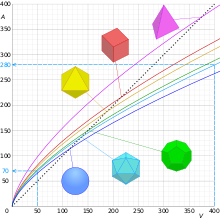Scaling: Why Is Animal Size So Important?

The square–cube law was first mentioned in 2 New Sciences (1638).
The square–cube law (or cube–square law) is a mathematical principle, practical in a variety of scientific fields, which describes the human relationship between the volume and the surface area as a shape's size increases or decreases. It was starting time described in 1638 by Galileo Galilei in his Two New Sciences as the "...ratio of two volumes is greater than the ratio of their surfaces".[ane]
This principle states that, as a shape grows in size, its volume grows faster than its area. When applied to the real world this principle has many implications which are important in fields ranging from mechanical applied science to biomechanics. It helps explain phenomena including why large mammals like elephants accept a harder time cooling themselves than small ones like mice, and why building taller and taller skyscrapers is increasingly difficult.
Clarification [edit]

Graphs of area, A against volume, V of the Platonic solids and a sphere, showing that the surface-area-to-volume ratio decreases with increasing book. Their intercepts with the dashed lines show that when the volume increases eight (ii³) times, the surface area increases four (2²) times.

This picture show clarifies the relationship between a polyhedron'southward side length, its surface area, and its volume.
The square–cube constabulary can exist stated as follows:
When an object undergoes a proportional increase in size, its new surface area is proportional to the square of the multiplier and its new volume is proportional to the cube of the multiplier.
Represented mathematically:[2]
where is the original surface area and is the new surface expanse.
where is the original volume, is the new volume, is the original length and is the new length.
For case, a cube with a side length of 1 meter has a surface surface area of 6 m2 and a volume of 1 m3. If the dimensions of the cube were multiplied by 2, its surface surface area would be multiplied by the square of ii and go 24 mtwo. Its volume would exist multiplied by the cube of 2 and get 8 yard3.
The original cube (1m sides) has a surface expanse to book ratio of half-dozen:i. The larger (2m sides) cube has a surface surface area to book ratio of (24/8) three:1. Every bit the dimensions increase, the volume volition go along to grow faster than the surface area. Thus the foursquare–cube police force. This principle applies to all solids.[3]
Applications [edit]
Engineering science [edit]
When a physical object maintains the aforementioned density and is scaled up, its book and mass are increased by the cube of the multiplier while its surface surface area increases just by the square of the same multiplier. This would mean that when the larger version of the object is accelerated at the same rate as the original, more than pressure level would be exerted on the surface of the larger object.
Consider a simple example of a body of mass, Yard, having an acceleration, a, and surface expanse, A, of the surface upon which the accelerating force is interim. The strength due to acceleration, and the thrust pressure, .
At present, consider the object exist exaggerated by a multiplier factor = x and then that it has a new mass, , and the surface upon which the force is acting has a new area, .
The new force due to acceleration and the resulting thrust pressure,
Thus, just scaling up the size of an object, keeping the same material of structure (density), and same acceleration, would increase the thrust by the same scaling factor. This would indicate that the object would accept less ability to resist stress and would be more prone to collapse while accelerating.
This is why large vehicles perform poorly in crash tests and why there are theorized limits equally to how high buildings can be congenital. Similarly, the larger an object is, the less other objects would resist its motion, causing its deceleration.
Engineering examples [edit]
- Steam engine: James Watt, working every bit an instrument maker for the Academy of Glasgow, was given a scale model Newcomen steam engine to put in working order. Watt recognized the trouble as being related to the square–cube law, in that the surface to volume ratio of the model'southward cylinder was greater than that of the much larger commercial engines, leading to excessive heat loss.[four] Experiments with this model led to Watt'southward famous improvements to the steam engine.

A Boeing 737-500 in forepart of an Airbus A380
- Airbus A380: the lift and control surfaces (wings, rudders and elevators) are relatively large compared to the fuselage of the plane. For example, taking a Boeing 737 and merely magnifying its dimensions to the size of an A380 would consequence in wings that are also small-scale for the aircraft weight, because of the square–cube rule.
- Expander bicycle rocket engines endure from the square–cube constabulary. Their size, and therefore thrust, is limited by estrus transfer efficiency due to the surface area of the nozzle increasing slower than the volume of fuel flowing through the nozzle.
- A clipper needs relatively more than sail surface than a sloop to attain the aforementioned speed, pregnant there is a college sail-surface-to-canvass-surface ratio between these craft than there is a weight-to-weight ratio.
- Aerostats generally benefit from the square–cube law. Every bit the radius ( ) of a balloon is increased, the cost in surface surface area increases quadratically ( ), just the elevator generated from volume increases cubically ( ).
- Structural Technology: Materials that work at pocket-size scales may not work at larger scales. For case, the compressive stress at the bottom of small costless-standing cavalcade scales at the same rate as the size of the cavalcade. Therefore, there exists a size for a given material and density at which a cavalcade volition plummet on itself.
Biomechanics [edit]
If an animal were isometrically scaled up by a considerable amount, its relative muscular forcefulness would be severely reduced, since the cantankerous section of its muscles would increment by the square of the scaling factor while its mass would increment past the cube of the scaling cistron. As a consequence of this, cardiovascular and respiratory functions would exist severely burdened.
In the example of flying animals, the wing loading would be increased if they were isometrically scaled up, and they would therefore accept to wing faster to proceeds the same amount of lift. Air resistance per unit mass is also higher for smaller animals (reducing terminal velocity) which is why a pocket-size fauna like an ant cannot exist seriously injured from affect with the ground after beingness dropped from whatsoever height.
Every bit stated past J. B. Southward. Haldane, large animals practise not look like pocket-size animals: an elephant cannot be mistaken for a mouse scaled upwards in size. This is due to allometric scaling: the bones of an elephant are necessarily proportionately much larger than the basic of a mouse, because they must carry proportionately higher weight. Haldane illustrates this in his seminal 1928 essay On Beingness the Right Size in referring to allegorical giants: "...consider a man 60 feet high...Giant Pope and Giant Pagan in the illustrated Pilgrim's Progress: ...These monsters...weighed grand times equally much as [a normal human]. Every square inch of a giant os had to back up ten times the weight borne by a square inch of human bone. Equally the average human thigh-bone breaks under most 10 times the human being weight, Pope and Pagan would have broken their thighs every fourth dimension they took a step."[5] Consequently, about animals prove allometric scaling with increased size, both amongst species and within a species. The behemothic creatures seen in monster movies (e.g., Godzilla, King Kong, and Them!) are also unrealistic, given that their sheer size would forcefulness them to plummet.
However, the buoyancy of water negates to some extent the effects of gravity. Therefore, sea creatures can abound to very large sizes without the same musculoskeletal structures that would exist required of similarly sized land creatures, and it is no coincidence that the largest animals to ever exist on globe are aquatic animals.
The metabolic rate of animals scales with a mathematical principle named quarter-power scaling[6] according to the metabolic theory of ecology.
Mass and heat transfer [edit]
Mass transfer, such as diffusion to smaller objects such equally living cells is faster than improvidence to larger objects such as entire animals. Thus, in chemical processes that take place on a surface – rather than in the majority – finer-divided material is more agile. For instance, the activity of a heterogeneous catalyst is higher when it is divided into effectively particles. Such catalysts typically occur in warmer conditions.
Heat production from a chemical process scales with the cube of the linear dimension (summit, width) of the vessel, merely the vessel surface expanse scales with only the square of the linear dimension. Consequently, larger vessels are much more hard to cool. Besides, large-scale pipe for transferring hot fluids is difficult to simulate in small calibration, because rut is transferred faster out from smaller pipes. Failure to take this into business relationship in process design may lead to catastrophic thermal runaway.
See as well [edit]
- Biomechanics
- Allometric police force
- On Existence the Correct Size, an essay by J. B. South. Haldane that considers the changes in shape of animals that would be required past a big change in size
- Surface-area-to-volume ratio
- Kleiber'south police
- Bergmann'south dominion
References [edit]
- ^ David H. Allen (24 September 2013). How Mechanics Shaped the Modern World. book. ISBN9783319017013.
- ^ "World Builders: The Sizes of Living Things". world-builders.org. Archived from the original on 2016-10-23. Retrieved 2012-04-21 .
- ^ Michael C. LaBarbera. "The Biology of B-Moving-picture show Monsters".
- ^ Rosen, William (2012). The Well-nigh Powerful Idea in the World: A Story of Steam, Industry and Invention. University of Chicago Press. p. 98. ISBN978-0226726342.
- ^ Haldane, J. B. South. "On Being the Right Size". Internet Inquiry Lab. UCLA. Archived from the original on 22 August 2011. Retrieved 1 April 2017.
- ^ George Johnson (January 12, 1999). "Of Mice and Elephants: A Matter of Scale". The New York Times . Retrieved 2015-06-11 .
Source: https://en.wikipedia.org/wiki/Square%E2%80%93cube_law
Posted by: byerssuman1965.blogspot.com


















0 Response to "Scaling: Why Is Animal Size So Important?"
Post a Comment